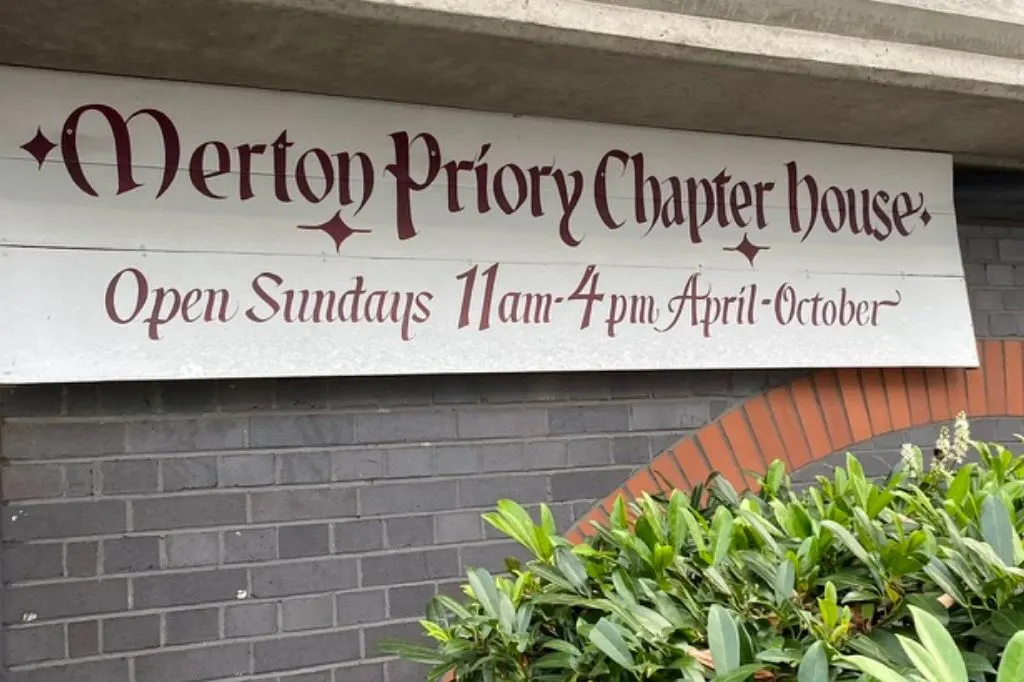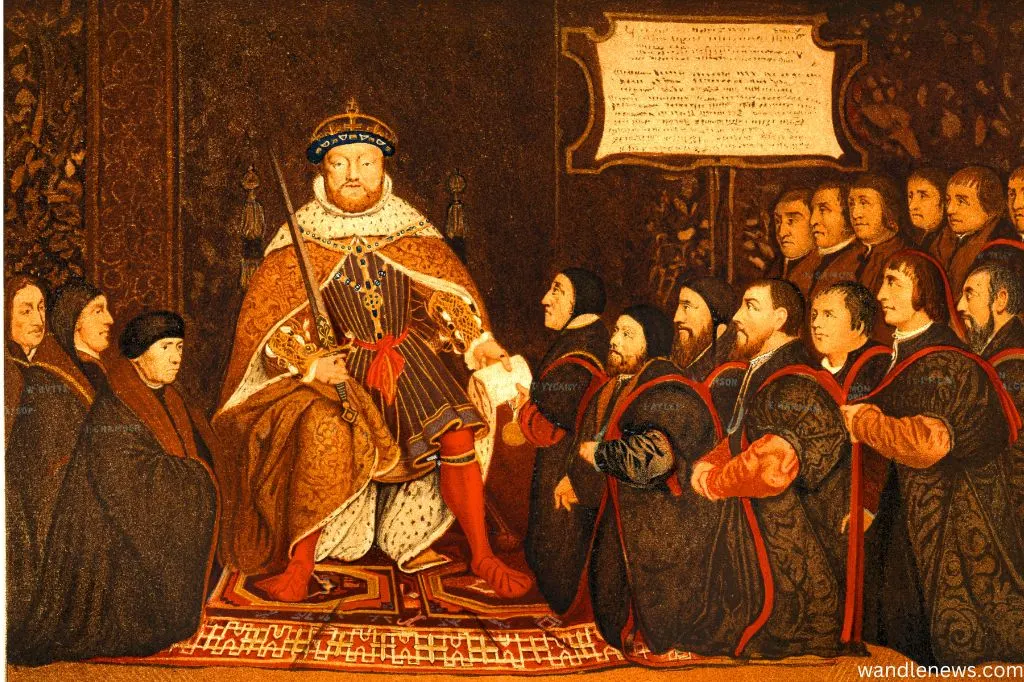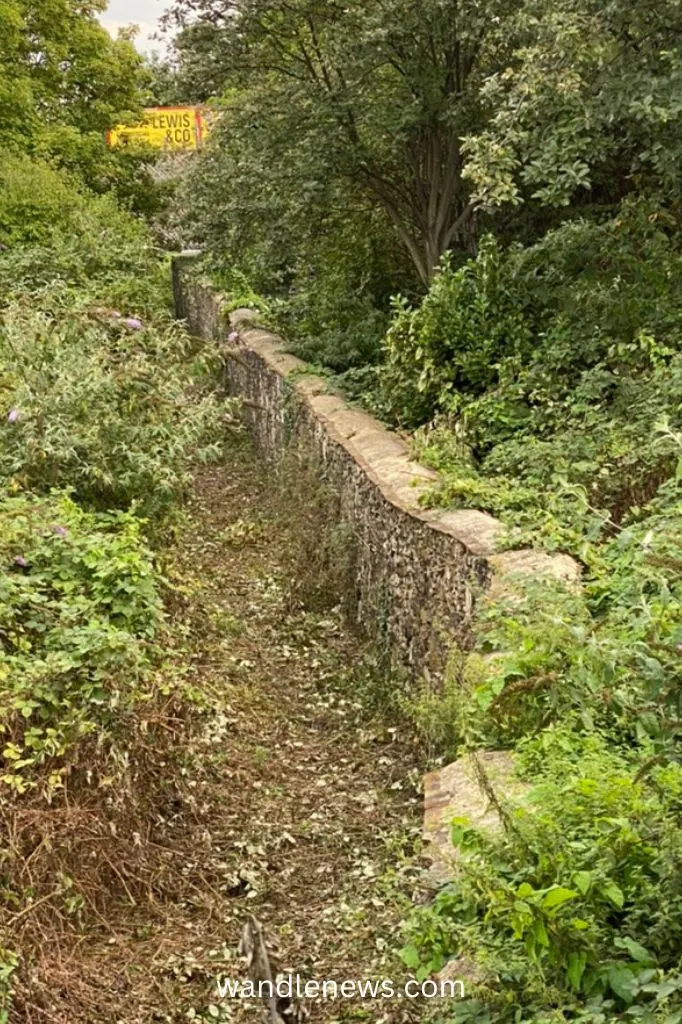In the 12th century, a large church called Merton Priory once stood on the banks of the river Wandle. It was the size of Westminster Abbey, and was one of the most important buildings in England for religion and learning.
This post is all about the history of Merton Priory, with details about where you can view the remains of the Priory foundation and walls.

What was Merton Priory?
Merton Priory was a vast, and beautiful church which stood in Merton for 400 years from 1117-1538. It was, at the time, the largest building in the area, being the same length as Westminster Abbey.
The Priory was founded in 1114 by Gilbert Norman, Sheriff of Surrey, under King Henry I. It was a place where monks lived a life of prayer, but it also served as a hospital, school, farm, watermill and brewery.
Merton Priory was also a major source of employment for local people in the 12th century. It owned large amounts of land, and had many tenant farmers who worked there and paid it rent and taxes.
Where did Merton Priory Once Stand?
The large Sainsbury’s in Collier’s Wood is on the site where Merton Priory once stood. You can see on the map below that the A24 road runs alongside the Sainsbury’s superstore. This road was actually a historic road built by the Romans almost 2,000 years ago. Once named Stane Street, it connected London to Chichester, and ran alongside Merton Priory.
Why Does Merton Priory No Longer Exist?
In 1537, Henry VIII abolished the Roman Catholic monasteries in England, and took their wealth and property. Many of the bigger churches were kept, and became cathedrals of the church of England, but Merton Priory was deliberately taken apart.
Henry VIII’s men took the stone and timber from Merton Priory, and used it to build Nonsuch Palace, which was about four miles away from the original Merton Priory site. When they had finished, only the foundations of the Priory remained.

Where Can You See Remains of Merton Priory
Today, the foundations of the original Priory Chapter House, and a stretch of the original boundary wall still exist, and can be viewed.
Merton Priory Chapter House
In 1921, excavations began to uncover the foundations of Merton Priory. In 1980, the remains of Merton Priory Chapter House were uncovered, and in 1986, when Sainsbury’s began building their superstore, the remaining foundations of Merton Priory were found.
Unfortunately they have now been reburied under Sainsbury’s car park, but Merton Priory Chapter House was kept, and the road next to Sainsbury’s was raised so these remains could be preserved underneath.
Merton Priory Chapter House, built around 1130, was one of the oldest parts of the original Priory. It would have been used as a board room and centre of administration, and was one of the most important buildings in the Priory.
Merton’s Chapter House was a Norman Chapter House, like the one at Bristol Cathedral. Like Bristol’s chapter house, it was at first rectangular, but later it was enlarged with a curved wall on the east end, so it may have looked more like the chapter house at Durham Cathedral.
Today you can visit Merton Priory Chapter House and see the remains of its original foundation, shown in the photograph below.

You can access Merton Priory Chapter House via the foot tunnel at the back of Sainsbury’s and Marks and Spencer.
The Boundary Wall Next to Sainsbury’s Car Park
There is one stretch of the wall marking the Priory’s original boundary which can be found along the side of Sainsbury’s car park, in between the superstore and the Pickle. This is marked on the map above, and shown in the photograph below.
This stretch of wall is currently not open to the public, but there are plans to build a small park next to the wall where people will be able to view the wall up close.

Parts of the Boundary Wall on Station Road
On Station Road you can still see parts of the original flint wall that formed the boundary to the Priory. There also once stood a gateway between Station Road and Merantun Way, which had a stone arch dating from the 12th century. Unfortunately the gateway was vandalised in 1983, and is no longer there.

The Colour House Theatre in Merton Abbey Mills
The Colour House Theatre in Merton Abbey Mills is built of flint, in the same style as the medieval walls. It is believed that this building was one of the original buildings belonging to Merton Priory.
St Mary’s Church, Merton
St Mary’s Church was founded by the Augustinian monks who also founded Merton Priory. The walls of the bell tower date back to 1115 and its main entrance to 1121.
What Might Merton Priory Have Looked Like?
Merton Priory was a monastery of the Augustinian Order, where the monks wore black cloaks. The cathedrals of Southwalk, Oxford and Bristol were also once Augustinian monasteries. These buildings can give us an idea today, of what Merton Priory might have looked like in the 12th century.
Excavations uncovered many fragments of stone which also provide clues as to the Priory’s appearance. Some were made from sandstone from quarries near Reigate, and others were from hard rock that originated in Caen, in Normandy. Purbeck marble from Dorset, was also found.
We know that Purbeck marble turns black when it is polished, as this can be seen in the pillars of Salisbury Cathedral.
Famous People Who Had Connections with Merton Priory
Merton Priory had strong royal connections and was visited by many kings including King John, Henry III, Henry IV, King Henry VI, and Henry VIII who had it knocked down.
Thomas Becket
Merton Priory was known as a centre of learning, and one of its most famous pupils was Thomas Becket who was educated there for two years as a child.
Thomas Becket was King Henry II’s chancellor, and used his influence with the King to finance the Priory’s great naive.
Becket later became Arch Bishop of Canterbury, and after an argument with the King was famously murdered in 1170.

King John
King John is known to have stayed at Merton Priory, and it was there that King John agreed to the terms of the Magna Carta.
It has been suggested that copies of the Magna Carta may have been made at Merton Priory, since the Priory had a large writing school. There is no evidence however to back this up.
Henry III
Henry III held a parliament at Merton Priory in 1236, which was the first of its kind. It was in this parliament at Merton Priory where the first law in the English law book was drawn up.
The council held at Merton Priory was the forerunner of our parliamentary legal system.
Walter de Merton – Founder of Merton College Oxford
Walter de Merton, who was educated at Merton Priory, and one of Henry III’s chief officials, could be viewed as one of the founders of English universities.
In the 1260s he established a college close to Merton Priory, in the nearby village of Malden. In 1274 he relocated this college to Oxford, and it became known as Merton College.
Merton College was one of the oldest colleges of Oxford University, and the original model for collegiate life at Oxford and Cambridge.
Other Archaeological Discoveries
The Augustinian priory of Merton wasn’t just a place of worship and study, but also a hospital and burial site. The foundations of other buildings belonging to the priory, such as the hospital, were uncovered during the excavations in the 1980s, as well as the remains of coffins and skeletons.
The Hospital
The Priory had a hospital next to it which was where the monks cared for the sick. The hospital had a medicinal garden attached to it, to grow the herbs and plants, that the monks would have used.
Burials
Archaeological evidence showed there were 738 burials on the site of the Priory. Over 30 were under the floor of the Chapter House. The remains of coffins carved out of limestone were found which would have belonged to the priors.
Useful Links
- The Merton Priory Trust website has lots of information about the history of the Priory
- You can read about Henry VIII’s dissolution of the monasteries at History Hit
- The Records of Merton Priory was written in 1898 by Major Alfred Heales who collected every record he could trace relating to Merton Priory
- The Museum of London Archaeology make a full colour booklet about the history of the Priory
This post was about Merton Priory
Thank you for reading my post about Merton Priory. Merton Priory stood on the banks of the river Wandle in the early 12th century, and is one of the points of interest on the Wandle Trail. If you are walking the Wandle Trail, you will find Merton Priory in between Morden Hall Park and the original site of the William Morris Factory. The remains of the Priory are well worth seeing – please leave me a comment below if you have visited.

Peter Evans
Monday 19th of September 2022
Olivia, What a strange coincidence. I visited the museum under the A24 yesterday (18/09/2022) and found it fascinating. Today a friend sent me this article of yours as we both belong to a group called Walk And Talk which is great because I do not use Twitter. I found your article very succinct and informative, well written and engaging. When I visited yesterday I too took some photos, some of which are similar to the ones you use, and shared them with friends on facebook. I am planning a return visit to the museum (and the William Morris pub) with friends along with a walk to and from Morden along the Wandle on the afternoon of Sunday 9th October. Thank you for this article, I shall share it with the three friends with whom I plan to do the walk in October as I'm sure they will find it just as interesting as I did.
Teresa
Sunday 18th of September 2022
I have just read the latest addition about the Merton Priory on your Wandle walks. It is so fascinating and informative with such well researched points of interest. I didn't realise it had so many links with charcters that had connections to the Priory like St Thomas Becket , various Kings that had visited and of course the the foundation of Merton college. Will try to visit the places you have mentioned as soon as possible. Love your research , please write more. What history we have on our doorstep.